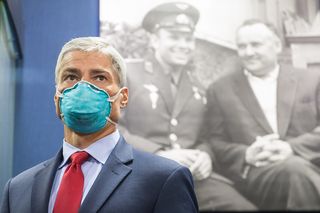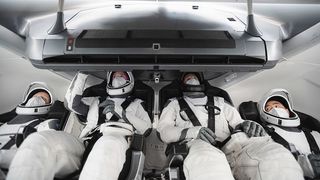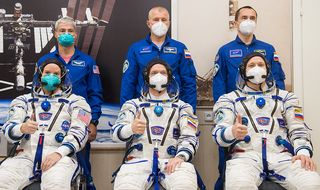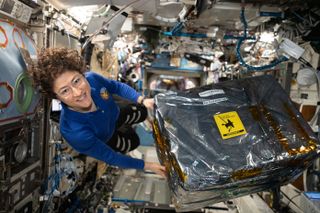Here's how NASA just booked a last-minute trip to space on a Russian Soyuz
NASA astronaut Mark Vande Hei will visit the space station next month.

It's no easy feat to get to space with just two months' notice — even for NASA.
But in February, the agency announced it wanted a seat on the next Russian Soyuz launch, currently scheduled to lift off on April 9. And unlike recent flights, when NASA has paid Russia to ferry astronauts to and from the International Space Station, the agency wants to instead exchange, likely, a flight on a U.S. spaceship.
On Tuesday (March 9), NASA announced that astronaut Mark Vande Hei would fill that seat, confirming hints circulating through the spaceflight community. The assignment comes with just a month of notice, far shorter than is typical, and the full implications of the announcement remain unclear.
The request came at short notice, but reflects long-standing NASA priorities. "At NASA, we have a phrase we use often — dissimilar redundancy," Robyn Gatens, acting director for the International Space Station at NASA, said in a statement released Feb. 9. "That's NASA speak for saying we always have a back-up plan that ensures we have a path forward even if we encounter an issue with our initial approach."
Related: International Space Station at 20: A photo tour
The initial approach is the agency's long-awaited Commercial Crew Program, which in 2014 hired two companies, SpaceX and Boeing, to develop vehicles to ferry NASA astronauts to and from the space station — dissimilar redundancy in action again.
"We're planners," Kathy Lueders, NASA's associate administrator of the Human Exploration and Operations Mission Directorate, said during a news conference held on March 1 to discuss SpaceX's Crew-2 mission — the company's third astronaut flight for NASA — due to launch next month. "We feel like us always flying a USOS [U.S. Orbiting Segment] crewmember up on every single vehicle going up and also us having multiple providers on the U.S. side is what protects us from all kinds of contingencies."
Get the Space.com Newsletter
Breaking space news, the latest updates on rocket launches, skywatching events and more!
After numerous delays, SpaceX has its first standard, six-month mission in orbit; a second such mission is targeting a late-April launch and the capsule has no known issues. But Boeing is still testing its vehicle, CST-100 Starliner, and its first full-fledged mission may slip to 2022.
And apparently, NASA is getting antsy.
Changing eras
On Oct. 14, NASA astronaut Kate Rubins stepped inside a Soyuz capsule with two Russian cosmonauts for what became the fastest trip to the space station to date.
Her flight cost $90 million as negotiated in May 2020 when, concerned that delays in the SpaceX and Boeing programs would strand the U.S. on Earth, NASA arranged one last seat purchase from its Russian counterpart, Roscosmos. Rubins and the two cosmonauts she launched with are due to return to Earth in late April, about a week after the next Soyuz capsule launches.
A month after Rubins' launch, four more astronauts made history by blasting off from Florida on the Crew-1 mission, the first full-fledged crew rotation on a SpaceX Crew Dragon capsule, marking the beginning of regular commercial crew flights to the orbiting laboratory. (In 2020, SpaceX also launched two astronauts on a shorter, four-month trip to the station on its Demo-2 mission.) The four Crew-1 astronauts are expected to return to Earth in late April or early May, according to NASA; their Crew-2 replacements are currently scheduled to launch on April 22, leaving time for the two crews to overlap.
But because space is a harsh environment, if something substantially delays Crew Dragon's next flight, the capsule in orbit may need to return before Crew-2 can launch. And because each capsule acts as a life-boat for the crew in case of emergency, with no spares, a crew can't be split to keep an American presence on the space station; that astronaut would be stranded if a catastrophe occurs.

As flight assignments currently stand, if Crew-1 must return to Earth before Crew-2 launches, the space station would host just three cosmonauts, with no astronauts on the American side of the orbiting laboratory, which is dubbed the U.S. Orbiting Segment.
For NASA, that's a problematic scenario, nearly as dire as astronauts being forced to completely abandon the space station.
So in early February, NASA announced it was looking to snag a seat on the Soyuz capsule scheduled to launch in April. The agency prefered not to pay for the seat, either, the notice stated, instead implying the agency would provide the same service in return in the future.
Yesterday's announcement doesn't clarify all the details of the new arrangement. NASA's news release reads like any other crew assignment announcement, focusing on Vande Hei's background and the importance of the space station and its science.
The Russian version of the news offers more detail on the logistics of the arrangement with NASA. An English-language Roscosmos statement also published on Tuesday notes that the flight will become part of a previous agreement between the Russian space agency and Axiom Space.
The Houston-based company is aiming to launch private missions to the International Space Station beginning next year, then to establish a freeflying space station later this decade.
A separate NASA release published March 9 confirms that in exchange for next month's flight, NASA will fly an Axiom-selected astronaut on a future U.S. commercial crew vehicle flight, expected to launch in 2023 and confirms that no money was exchanged in the arrangement.

A seat on every flight
NASA's fear of again being grounded was part of the logic for selecting two different commercial crew providers at the beginning of the program: If a problem grounds one vehicle, the other can pick up the slack — precisely the sort of dissimilar redundancy that NASA loves.
But SpaceX's counterpart, Boeing, has been facing a rockier road to flight. Its capsule, the CST-100 Starliner, launched on an uncrewed test flight in December 2019. Had the mission gone smoothly, Starliner too might be flying regular crews by now. Instead, software glitches meant the vehicle couldn't reach the space station as planned and returned to Earth early.
The company still needs to complete a second attempt at the uncrewed test flight, but that mission, dubbed OFT-2, has been delayed multiple times and won't fly before late April. And even after Boeing notches that achievement, a successful crewed test flight must follow before NASA will consider Starliner in full service and that much-desired dissimilar redundancy achieved.
Then, there's the standby Soyuz. NASA has long held that the beginning of commercial flights to the space station should not mark the end of NASA astronauts riding on Soyuz vehicles. Instead, throughout the leadup to the commercial crew era, NASA has argued for seat trades with Roscosmos (Russia's space agency) that would ensure neither of the two leading space station partners loses access to the orbiting laboratory, even if a vehicle issue arises.
"We love the fact that we're working toward a capability and moving to have in place the international agreements where we will be able to fly our crew members up on a Soyuz, have Roscosmos fly their crew members up on one of our two commercial crew providers and move forward into this new age," Lueders said during the March 1 news conference. "It gives us the most robust logistics strategy."
While NASA has confidently touted the seat-exchange strategy, Russia has not yet agreed to that procedure for any mission.
Acting NASA Administrator Steve Jurczyk told Space.com in an interview last month (before the agency announced it was seeking the spring Soyuz seat) that NASA believes Roscosmos will be willing to put cosmonauts on a commercial vehicle after three successful crewed flights; SpaceX's Crew-2 flight this spring would be that third flight for Crew Dragon. (Requests to interview Jurczyk and Lueders about this year's flight arrangements on Soyuz and Crew Dragon were not acknowledged.)
Roscosmos declined to confirm the three-flight policy or to clarify whether the third mission would need to land before Russia entrusted cosmonauts to a new vehicle. "The flights of Roscosmos cosmonauts on U.S. commercial vehicles are subject to negotiations that are currently underway," a representative of the Roscosmos Press Office told Space.com in an email. Neither agency's release about Vande Hei's assignment discusses whether or when cosmonauts will begin flying on commercial vehicles.

Shifting assignments
As of November, the April Soyuz launch was scheduled to carry only cosmonauts. Now, that has changed, and later in the process than agencies usually exchange seats.
"The crew composition change came as a result of an earnest request from the U.S. side," Roscosmos personnel wrote in Tuesday's statement. "NASA voiced its request only in the end of 2020, meaning the Russian side had to change the already confirmed and approved launch program. Roscosmos has taken this decision confirming its adherence to the joint agreements and the spirit of joint usage of the International Space Station."
In November, a Roscosmos statement announced a prime crew consisting of veteran cosmonaut Oleg Novitskiy and rookies Pyotr Dubrov and Sergey Korsakov. A second trio of cosmonauts were listed as back-up crew members; one was later substituted for medical reasons, according to a January statement.
But in a Feb. 24 statement, both primary and back-up crews appeared to be down to two cosmonauts apiece. While not specifying that a cosmonaut had been cut, the statement refers to only Novitskiy and Dubrov as having completed a specific exam related to the Nauka science module that Russia will launch later this year. In an additional statement released March 5, the agency continues this pattern, referring to Novitskiy and Dubrov as the main crew.
Soyuz capsules rarely fly with an empty seat; the last time a two-person crew climbed aboard was in October 2018, when a launch carrying cosmonaut Alexey Ovchinin and NASA astronaut Nick Hague aborted due to a rocket issue. When the duo went for a second attempt at spaceflight the following spring, they were joined by NASA astronaut Christina Koch, bringing the capsule up to its full capacity.
Vande Hei's assignment comes on remarkably tight notice, but late crew changes are not unheard of — and this time, there was a prime candidate waiting in the wings.
Typically, NASA astronauts are assigned to a particular flight 18 to 24 months in advance, NASA spokesperson Brandi Dean wrote in an email to Space.com before the assignment was announced. "In unique circumstances, that training time can be significantly shortened based on currency of qualifications, recency of flight, etc." Dean noted specifically a shuttle mission in 2010 when an astronaut was substituted with six weeks notice; the Soyuz launch is approaching four weeks before blast-off.
However, Vande Hei offers a particularly smooth substitution, as he served as the back-up for Rubins before her October launch; Novitskiy and Dubrov were the back-up crew's cosmonauts, so the trio has already trained together extensively.

Uncertainty this fall
The Russian side of the story becomes even more complicated later this year. Roscosmos is next expected to launch a Soyuz vehicle in the fall, but that flight may not be a typical spaceflight mission.
In a November statement, the agency announced that it was working with Channel One Russia to create a space drama actually filmed in space, noting that said shoot would occur on the International Space Station in the fall of 2021. (The announcement was generally seen as a response to May 2020 reports that actor Tom Cruise was working with SpaceX and NASA to film in space.)
To that end, the film team has been recruiting a female actor to fly to space, plus an understudy. According to a Russian-language release published on March 9, the selection process has narrowed a field of 3,000 applicants down to 20 candidates, who will now undergo medical examinations.
That release also confirms that the film's director, Klim Shipenko, will make the flight as well, filling two of any Soyuz capsule's three seats. It's difficult to imagine Roscosmos would allow a Soyuz to either launch or return without one of its cosmonauts at the helm. The Roscosmos Press Office representative declined to confirm whether the movie is still on track for filming this fall, saying that the timeline was under the purview of Channel One Russia.
Russia has occasionally flown passengers who don't represent an agency partner of the space station. These stays typically last about a week and take advantage of the overlap period when a departing crew and a returning crew are both in orbit to offer a brief stay in orbit.
Given past practices and the tentative filming schedule, the return flight of April's Soyuz vehicle may be destined to carry two passengers and one cosmonaut, leaving zero seats available for a astronaut. However, such a situation isn't a dealbreaker and may even offer NASA a valuable opportunity.
The last time a Soyuz capsule facilitated a flight beyond the core International Space Station partnership might offer a template for how filming might affect astronaut flights this year.
In the fall of 2019, the United Arab Emirates hired Roscosmos to launch its first astronaut, Hazzaa AlMansoori, for a one-week stay in orbit. In conjunction with this launch, two NASA astronauts spent longer than the usual six and a half months in orbit: Koch's stay was extended to 11 months and Andrew Morgan's was extended to nine months. The extensions were announced when Koch was already in orbit.
While such longer stays are unusual, they aren't undesirable — quite the opposite, NASA has said. Right now, the agency has very little data about how the human body withstands spending more than about 200 days in orbit: Of American astronauts, only Koch and Scott Kelly have made a single spaceflight longer than 300 days and only Peggy Whitson and Morgan have broken 250 days at a time, according to NASA.

But next decade, NASA wants to send humans to Mars, a feat that requires a long stay in space, so the agency has been on the hunt for more data. In late 2019, NASA confirmed it wanted to add 10 more astronauts to the ranks of the long flyers. To date, without control of the vehicles that travel to orbit, NASA has had limited ability to coordinate such stays.
Vande Hei's launch followed by Russian film personnel filling the fall Soyuz launch could suggest he'll be remaining in orbit for more than the typical six and a half months. Notably, the NASA release announcing his assignment does not state a duration or return date, which recent assignment announcements typically do.
On the other side of the collaboration, NASA seems to be holding seats on upcoming crewed flights in reserve. SpaceX Crew Dragon and Boeing Starliner capsules each carry four astronauts for regular space station missions.
SpaceX's Crew-3 mission, due to launch this fall, has three astronauts already assigned to it: NASA astronauts Raja Chari and Tom Marshburn and European Space Agency (ESA) astronaut Matthias Maurer, leaving one remaining astronaut to be announced.
The following SpaceX launch, 2022's Crew-4, has two astronauts assigned, NASA's Kjell Lindgren and Bob Hines, with the other two crewmembers yet to be announced. The first full-fledged Starliner mission, which will fly in late 2021 or early 2022, also has a lingering empty seat.
All three of these upcoming launches are within the 18 to 24 month window that Dean identified as standard for NASA astronaut assignments. NASA could still assign its own astronauts to one or more of those seats. Otherwise, agencies in the space station partnership typically fly crewmembers according to their relative contribution to the facility, with NASA and Roscosmos as the lead partners.
Of announced assignments, JAXA has one astronaut each on Crew-1 and Crew-2; ESA has a seat each on Crew-2 and Crew-3. Of the partner agencies, that leaves Roscosmos and the Canadian Space Agency, which has only four active astronauts, making it unlikely to fill more than one of the currently open seats on commercial vehicles.
Editor's note: This story was updated to include details from a NASA statement regarding the arrangements with Axiom Space. Email Meghan Bartels at mbartels@space.com or follow her on Twitter @meghanbartels. Follow us on Twitter @Spacedotcom and on Facebook.
Join our Space Forums to keep talking space on the latest missions, night sky and more! And if you have a news tip, correction or comment, let us know at: community@space.com.

Meghan is a senior writer at Space.com and has more than five years' experience as a science journalist based in New York City. She joined Space.com in July 2018, with previous writing published in outlets including Newsweek and Audubon. Meghan earned an MA in science journalism from New York University and a BA in classics from Georgetown University, and in her free time she enjoys reading and visiting museums. Follow her on Twitter at @meghanbartels.
